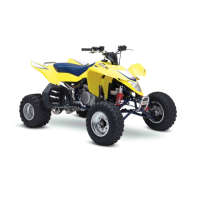1C-4 Engine Electrical Devices:
ECT Sensor Removal and Installation
B831G21306011
Removal
1) Drain engine coolant. Refer to “Cooling System
Inspection in Section 0B (Page 0B-15)”.
2) Disconnect the coupler (1) and remove the ECT
sensor (2).
CAUTION
!
Take special care when handling the ECT
sensor. It may cause damage if it gets an
excessive impact.
Installation
Install the ECT sensor in the reverse order of removal.
Pay attention to the following points:
• Tighten the ECT sensor to the specified torque.
CAUTION
!
Use the new gasket washer (1) to prevent
engine coolant leakage.
Tightening torque
ECT sensor (a): 18 N·m (1.8 kgf-m, 13.0 lb-ft)
• Pour engine coolant. Refer to “Cooling System
Inspection in Section 0B (Page 0B-15)”.
ECT Sensor Inspection
B831G21306012
Refer to “DTC “C15” (P0115-H/L): ECT Sensor Circuit
Malfunction in Section 1A (Page 1A-41)”.
Inspect the ECT sensor in the following procedures:
1) Remove the ECT sensor. Refer to “ECT Sensor
Removal and Installation (Page 1C-4)”.
2) Connect the ECT sensor (1) to a circuit tester and
place it in the oil (2) contained in a pan, which is
placed on a stove.
3) Heat the oil to raise its temperature slowly and read
the column thermometer (3) and the ohmmeter.
If the ECT sensor ohmic valve does not change in
the proportion indicated, replace it with a new one.
CAUTION
!
Do not contact the ECT sensor and the
column thermometer with a pan.
Special tool
(A): 09900–25008 (Multi-circuit tester set)
Tester knob indication
Resistance (Ω)
Temperature sensor specification
4) Install the ECT sensor. Refer to “ECT Sensor
Removal and Installation (Page 1C-4)”.
1
2
I831G1130010-01
1
(a)
I831G1130011-01
Temperature Standard resistance
20 °C (68 °F) Approx. 2.45 kΩ
50 °C (122 °F) Approx. 0.811 kΩ
80 °C (176 °F) Approx. 0.318 kΩ
110 °C (230 °F) Approx. 0.142 kΩ
(A)
2
1
3
I718H1130014-01

